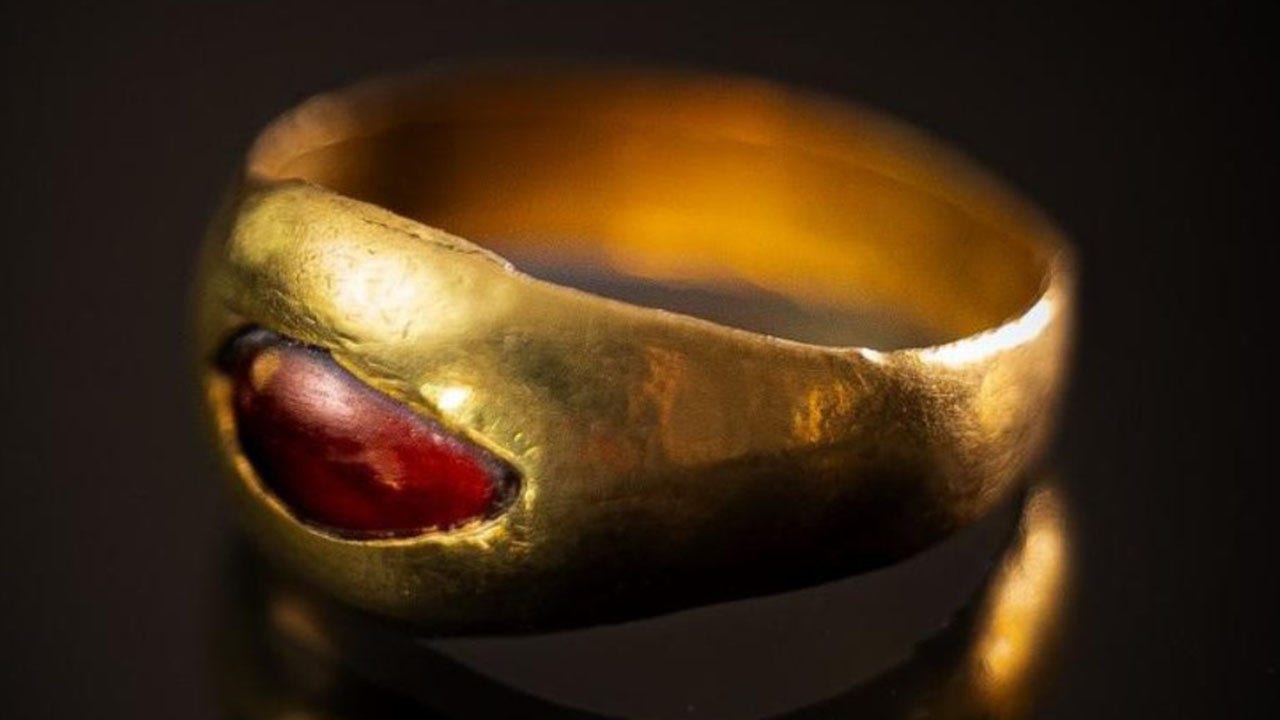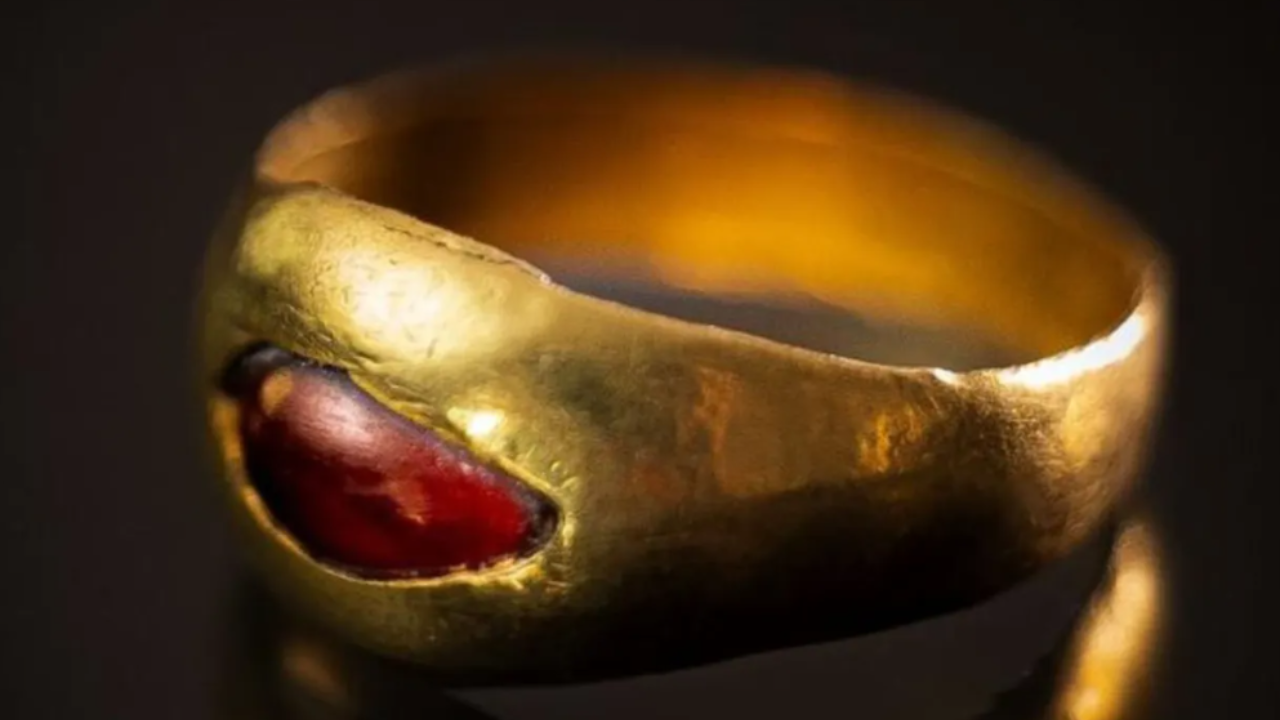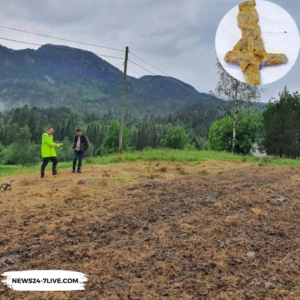Archaeologists from the Israel Antiquities Authority (IAA) and Tel Aviv University (TAU) have uncovered a 2,300-year-old gold ring at the Givati Parking Lot excavation site located just outside Jerusalem’s Old City. This find was announced on May 27, 2024.

Also Read: Koleken Inakayali: New Dinosaur Species with Tiny Arms Discovered in Patagonia
The ring was discovered in the Givati Parking Lot, an area known for its rich historical layers and proximity to the City of David.
The announcement was made on May 27, 2024. The excavation is part of the larger Jerusalem Walls National Park project supported by the Elad Foundation which aims to uncover and preserve Jerusalem’s ancient history.
Approximately 2,300 years old, dating back to the Hellenistic period specifically the late Fourth to early Third-century BCE.
The ring is crafted from highly refined gold remarkably well-preserved without rust or weathering over the millennia. It is set with a red garnet, indicating the luxurious nature of the item.
The ring is small suggesting it was likely made for a child, possibly a little boy or girl. It could also fit a woman’s pinkie finger.
The ring was created by hammering thin, pre-cut gold leaves onto a metal base, a technique of the craftsmanship during the Persian and early Hellenistic periods.
Tehiya Gangate, a member of the City of David excavation team discovered the ring while sifting earth through a screen.
Gangate expressed excitement upon finding the ring, exclaiming, “I found a ring, I found a ring!” Her discovery sparked great excitement among her colleagues.
Gold jewelry with set stones became fashionable during the Hellenistic period, a trend that spread through Alexander the Great’s conquests which facilitated the transport and trade of luxury goods.
The ring joins other Hellenistic-era ornaments found in the City of David excavations such as a horned-animal earring and a decorated gold bead.
Historically, scholars believed Jerusalem was a small, provincial town during the Hellenistic period with limited resources and a small population confined to the top of the southeastern slope (City of David).
The findings including the gold ring suggest a more expansive urban area. The excavation has uncovered entire neighborhoods including both domestic and public buildings.
The presence of Hellenistic-style artifacts points to the cultural and economic connections between Jerusalem and the Hellenistic world.
To celebrate these discoveries, the IAA has organized a conference titled “Jerusalem Mysteries – The Archaeology of Jerusalem,” scheduled for June 5, 2024.
This event will be held at the IAA’s Jay and Jeanie Schottenstein National Campus for the Archaeology of Israel, near the Israel Museum.
The gold ring along with other discoveries from the Givati Parking Lot excavation will be put on public display for the first time during this conference.
Prof. Yuval Gadot and excavator Efrat Bocher from Tel Aviv University highlighted the importance of the ring within the context of the City of David excavations. They stressed that the discovery challenges previous assumptions about Jerusalem’s size and wealth during the early Hellenistic period.
Dr. Marion Zindel provided details on the ring’s stylistic elements and manufacturing technique linking it to the trends in Persian and Hellenistic jewelry design.
The gold ring adorned with a red precious stone believed to be a garnet was discovered at the City of David archaeological park in Jerusalem.
Also Read: Egypt’s Pyramids Mystery May Have Been Solved by Scientists
Due to its small diameter, experts suggest that the ring was likely worn by a child, possibly a boy or girl. The ring dates back to around 300 BC, placing it firmly in the early Hellenistic period.
The excavation was part of a joint project between the Israel Antiquities Authority and Tel Aviv University with support from the Elad Foundation.
Tehiya Gangate, a member of the excavation team made the discovery while sifting earth through a screen.
“I was sifting earth through the screen and suddenly saw something glitter. I immediately yelled, ‘I found a ring, I found a ring!'” said Gangate.
“Within seconds, everyone gathered around me, and there was great excitement.” Gangate expressed her joy, mentioning that finding gold jewelry was a personal dream which came true just a week before her maternity leave.
The ring is described as “exceedingly well-preserved,” with no signs of rust or weathering, which is unusual for such an ancient artifact.
It was manufactured by hammering thin pre-cut gold leaves onto a metal ring base. This method shows the common fashion of the Persian and Early Hellenistic periods, when gold with set stones became preferred over decorated gold.
The Hellenistic period in Jerusalem began after Alexander the Great’s conquest which spread Greek culture and influence across the eastern Mediterranean.
The ring’s style and craftsmanship indicate that Jerusalem’s residents were open to Hellenistic influences and luxury goods.
Gold jewelry was prevalent in the Hellenistic world and Alexander’s conquests facilitated the spread of such luxury items.
The City of David is the original core of the ancient biblical city located just outside the southern walls of Jerusalem’s Old City.
It is considered one of Israel’s most important archaeological sites known for its rich historical layers. The park includes Hezekiah’s Tunnel, a water channel constructed by King Hezekiah to provide water to the city during an Assyrian siege.
The gold ring joins other ornaments from the early Hellenistic period found in the City of David excavations including a horned-animal earring and a decorated gold bead.
These discoveries are helping researchers understand the nature of the settlement during this period. The gold ring will be displayed to the public at an Antiquities Authority conference on Jerusalem Day on June 4.
Also Read: Vatican Issues New Norms on Supernatural Phenomena























